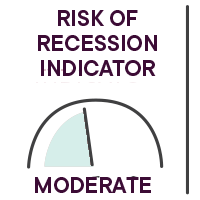Yann Furic
B.B.A., M. Sc., CFA®
Senior Portfolio Manager, Asset Allocation and Alternative Strategies
The Fed changes course
The Fed is expected to reduce its monthly bond purchases in November: at least that’s what came out of the Jackson Hole meeting in September. Two key indicators—an above-target inflation rate and job creation in line with expectations for the economic recovery—are prompting the Federal Reserve to reduce its monthly $120-billion injection of liquidity into the system.
Focus on the past month

Overview of global equity markets*
- The flagship index of the Canadian stock market, the S&P/TSX, fell 2.2% in September.
- In the United States, the S&P 500 lost 4.2% and the Nasdaq, 4.8%.
- International stock markets were also in negative territory during the month, with the EAFE Index declining 2.4%.
- Emerging market equities were off 3.5%, while Chinese stocks were down 4.6%.
* All the percentages in this section are in Canadian dollars. Bloomberg unless otherwise indicated.
Key events

New Fed stance
The Fed’s target inflation level has been reached and job creation appears to be well under way, despite a slight decline in September. The Fed should therefore start tapering its bond purchases in November.
What should be understood from these announcements is not that the Fed wants to sell its bonds, but rather that it will no longer be pumping new liquidity into the system. If conditions remain favourable, it will end its current monetary policy by June 2022. As for the decision to hike rates, it will undoubtedly be made later in 2022, or even in 2023, if the economy maintains its momentum.
Supply chain problems
For several months now, supply chain problems have been rampant almost everywhere in the world and the situation could continue during the first half of 2022. These supply chain disruptions are due in large part to higher demand for goods triggered by the pandemic. The effects are clearly visible in California ports, where record numbers of container ships are anchored waiting to be unloaded, while freight trains are overflowing and trucking companies are trying to recruit drivers and workers. This is delaying the return of containers to Asia and driving up the cost of transporting goods.
If this situation continues for much longer, the supply of goods could shrink and consumers could see prices rise significantly, which could lead to an episode of stagflation, i.e. a rise in prices without real economic growth, which is a bad scenario for the stock markets.
As far as businesses are concerned, this situation could translate into lower profit margins since in some cases the increased costs cannot be fully passed on to consumers.
Growth decelerating
Most economic measures are showing signs of slowing: growth is not negative, but the rate of growth is easing. Supply problems in certain industries such as automobile manufacturing are reducing potential GDP growth and could maintain inflationary pressures longer than expected.
The COVID-19 and vaccination situation
In North America, the fourth wave appears to have peaked. The global immunization rate continues to rise, although at different rates in different countries.
Employment
The creation of 157,100 jobs in Canada exceeded expectations of 60,000. The number of jobs is now back to pre-COVID levels. The unemployment rate fell from 7.1% to 6.9% and the labour force participation rate is positive at 65.5%, up from 65.1% in the previous month.
The 194,000 jobs created in the United States fell short of forecasts of 500,000. The unemployment rate fell from 5.2% to 4.8%, largely due to the decline in the labour force participation rate.
Results – Canadian bonds
Government of Canada bonds across maturities posted a negative return of 1.3% for the month. (Source: Canaccord Genuity)
Performance of our funds
View the returns

Our strategic monitoring
Main risks
Here are some risks that we are closely monitoring in the current environment.
- Global supply chains are experiencing disruptions which, if they continue, could cause inflation to rise and reduce the production of goods and services. Such a situation would generate an episode of stagflation.
- The current energy crisis in Europe and China could slow global economic growth.
- The cyclical recovery could be limited or delayed by various vaccine production problems, slow vaccination campaigns, or the spread of a vaccine-resistant variant.
- A major cyber attack could hamper the reopening of the global economy and hurt consumer confidence.
- A rapid, sharp rise in interest rates would lower the price/earnings ratio, which would cause stock indices to fall.
- Governments could significantly increase corporate and personal tax rates to replenish their coffers, an unlikely scenario in 2021.
Fundamental indicators
Some economic indicators we continued to follow in October.
Consumer confidence ![]()
Consumer confidence continued to weaken in September after declines in August and July. The upsurge in COVID-19 infections has weighed heavily on this indicator in recent months.
U.S. personal savings ![]()
The personal savings rate remains high. Supply chain problems, insufficient semiconductor production and a worker shortage are limiting purchases of certain categories of goods and services. For example, new car production is down this year, limiting the ability of consumers to buy a new vehicle.
Global Purchasing Managers’ Index ![]()
The index remains above 50, indicating an increase in purchasing managers’ intentions. The index peaked in May 2021 at 58.5 and is now at 53, slightly higher than in August. Intentions continue to be positive, but have been declining in recent months.
Benchmark rates in Canada, Europe and the United States ![]()
Rates remain favourable for an economic recovery, but could be raised over the next 12 to 18 months as the economic recovery is well underway and the employment situation has improved significantly.
François Landry
CFA®
Vice-President and Chief Investment Officer
Vice-Chairman of the Board of Directors of Professionals' Financial - Private Management
Our strategies
(6-to-12 month horizon)
The strategic target for the FDP Tactical Asset Allocation Private Portfolio is 55% equities and 45% bonds. According to our current strategy, the weighting of equities is 69% and bonds, 31%.
The geographic allocation of equities in our portfolios shows greater exposure to cyclical sectors. We are overweight Canada, the EAFE zone and the United States. We have no position in emerging markets. Sector or factor positioning varies from region to region.
- In terms of Canadian equities, we have had a favourable bias towards banks for several months and we have maintained our exposure to financial services. Canadian banks are still expected to get the regulatory go-ahead in the next few months to raise their dividends and resume share buybacks.
- As far as U.S. equities are concerned, our exposure to stocks in the technology and industrial products sectors remains unchanged.
- As for the EAFE Index (Europe, Australasia, Far East), we have an overweight position due to the index’s greater exposure to more cyclical sectors. Although the fiscal and monetary measures introduced in Europe are less aggressive than those implemented in North America, the zone should nevertheless benefit from an increase in commodity prices and a steeper yield curve, the wider spread between long-term and short-term yields being favourable for the banks.
François Landry, CFA
Vice-President and Chief Investment Officer
Yann Furic, B.B.A., M. Sc., CFA
Senior Portfolio Manager, Asset Allocation and Alternative Strategies
Sources: Bloomberg
The opinions expressed here and on the next page do not necessarily represent the views of Professionals’ Financial. The information contained herein has been obtained from sources deemed reliable, but we do not guarantee the accuracy of this information, and it may be incomplete. The opinions expressed are based upon our analysis and interpretation of this information and are not to be construed as a recommendation. Please consult your Wealth Management Advisor.




















